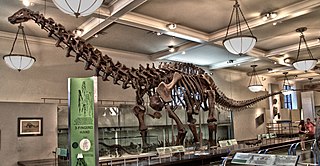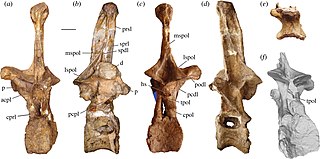
Apatosaurus is a genus of herbivorous sauropod dinosaur that lived in North America during the Late Jurassic period. Othniel Charles Marsh described and named the first-known species, A. ajax, in 1877, and a second species, A. louisae, was discovered and named by William H. Holland in 1916. Apatosaurus lived about 152 to 151 million years ago (mya), during the late Kimmeridgian to early Tithonian age, and are now known from fossils in the Morrison Formation of modern-day Colorado, Oklahoma, New Mexico, Wyoming, and Utah in the United States. Apatosaurus had an average length of 21–23 m (69–75 ft), and an average mass of 16.4–22.4 t. A few specimens indicate a maximum length of 11–30% greater than average and a mass of approximately 33 t.

Supersaurus is a genus of diplodocid sauropod dinosaur that lived in North America during the Late Jurassic period. The type species, S. vivianae, was first discovered by Vivian Jones of Delta, Colorado, in the middle Morrison Formation of Colorado in 1972. The fossil remains came from the Brushy Basin Member of the formation, dating between 153 to 145 million years ago. It was a very large sauropod, with the WDC and BYU specimens reaching 33–35 metres (108–115 ft) in length and approximately 35–40 metric tons in body mass. A potential second species, S. lourinhanensis, (Dinheirosaurus) is known from Portugal and has been dated to a similar time.

Sauropoda, whose members are known as sauropods, is a clade of saurischian ('lizard-hipped') dinosaurs. Sauropods had very long necks, long tails, small heads, and four thick, pillar-like legs. They are notable for the enormous sizes attained by some species, and the group includes the largest animals to have ever lived on land. Well-known genera include Brachiosaurus, Diplodocus, Apatosaurus, Camarasaurus and Brontosaurus.

Camarasaurus was a genus of quadrupedal, herbivorous dinosaurs and is the most common North American sauropod fossil. Its fossil remains have been found in the Morrison Formation, dating to the Late Jurassic epoch, between 155 and 145 million years ago.

Diplodocids, or members of the family Diplodocidae, are a group of sauropod dinosaurs. The family includes some of the longest creatures ever to walk the Earth, including Diplodocus and Supersaurus, some of which may have reached lengths of up to 42 metres (138 ft).

Barosaurus was a giant, long-tailed, long-necked, plant-eating sauropod dinosaur closely related to the more familiar Diplodocus. Remains have been found in the Morrison Formation from the Upper Jurassic Period of Utah and South Dakota. It is present in stratigraphic zones 2–5.

Macronaria is a clade of sauropod dinosaurs. Macronarians are named after the large diameter of the nasal opening of their skull, known as the external naris, which exceeded the size of the orbit, the skull opening where the eye is located. Fossil evidence suggests that macronarian dinosaurs lived from the Middle Jurassic (Bathonian) through the Late Cretaceous (Maastrichtian). Macronarians have been found globally, including discoveries in Argentina, the United States, Portugal, China, and Tanzania. Like other sauropods, they are known to have inhabited primarily terrestrial areas, and little evidence exists to suggest that they spent much time in coastal environments. Macronarians are diagnosed through their distinct characters on their skulls, as well as appendicular and vertebral characters. Macronaria is composed of several subclades and families notably including Camarasauridae and Titanosauriformes, among several others. Titanosauriforms are particularly well known for being some of the largest terrestrial animals to ever exist.

Opisthocoelicaudia is a genus of sauropod dinosaur of the Late Cretaceous Period discovered in the Gobi Desert of Mongolia. The type species is Opisthocoelicaudia skarzynskii. A well-preserved skeleton lacking only the head and neck was unearthed in 1965 by Polish and Mongolian scientists, making Opisthocoelicaudia one of the best known sauropods from the Late Cretaceous. Tooth marks on this skeleton indicate that large carnivorous dinosaurs had fed on the carcass and possibly had carried away the now-missing parts. To date, only two additional, much less complete specimens are known, including part of a shoulder and a fragmentary tail. A relatively small sauropod, Opisthocoelicaudia measured about 11.4–13 m (37–43 ft) in length. Like other sauropods, it would have been characterised by a small head sitting on a very long neck and a barrel shaped trunk carried by four column-like legs. The name Opisthocoelicaudia means "posterior cavity tail", alluding to the unusual, opisthocoel condition of the anterior tail vertebrae that were concave on their posterior sides. This and other skeletal features lead researchers to propose that Opisthocoelicaudia was able to rear on its hindlegs.

Euhelopus is a genus of sauropod dinosaur that lived between 145 and 133 million years ago during the Berriasian and Valanginian stages of the Early Cretaceous in what is now Shandong Province in China. It was a large quadrupedal herbivore. Like sauropods such as brachiosaurs and titanosaurs, Euhelopus had longer forelegs than hind legs. This discovery was paleontologically significant because it represented the first dinosaur scientifically investigated from China: seen in 1913, rediscovered in 1922, and excavated in 1923 and studied by T'an during the same year. Unlike most sauropod specimens, it has a relatively complete skull.

Brontosaurus is a genus of herbivorous sauropod dinosaur that lived in present-day United States during the Late Jurassic period. It was described by American paleontologist Othniel Charles Marsh in 1879, the type species being dubbed B. excelsus, based on a partial skeleton lacking a skull found in Como Bluff, Wyoming. In subsequent years, two more species of Brontosaurus were named: B. parvus in 1902 and B. yahnahpin in 1994. Brontosaurus lived about 156 to 146 million years ago (mya) during the Kimmeridgian and Tithonian ages in the Morrison Formation of what is now Utah and Wyoming. For decades, the animal was thought to have been a taxonomic synonym of its close relative Apatosaurus, but a 2015 study by Emmanuel Tschopp and colleagues found it to be distinct. It has seen widespread representation in popular culture, being the archetypal "long-necked" dinosaur in general media.

Patagosaurus is an extinct genus of eusauropod dinosaur from the Middle-Late Toarcian of Patagonia, Argentina. It was first found in deposits of the Cañadón Asfalto Formation, which date to around 179 to 177 million years ago. Although originally twelve specimens were assigned to the taxon, at least one of them may belong to a different genus. Patagosaurus probably lived alongside genera as Piatnitzkysaurus, Condorraptor and Volkheimeria.

Europasaurus is a basal macronarian sauropod, a form of quadrupedal herbivorous dinosaur. It lived during the Late Jurassic of northern Germany, and has been identified as an example of insular dwarfism resulting from the isolation of a sauropod population on an island within the Lower Saxony basin.

Camarasauridae is a family of sauropod dinosaurs. Among sauropods, camarasaurids are small to medium-sized, with relatively short necks. They are visually identifiable by a short skull with large nares, and broad, spatulate teeth filling a thick jaw. Based on cervical vertebrae and cervical rib biomechanics, camarasaurids most likely moved their necks in a vertical, rather than horizontal, sweeping motion, in contrast to most diplodocids.

Neosauropoda is a clade within Dinosauria, coined in 1986 by Argentine paleontologist José Bonaparte and currently described as Saltasaurus loricatus, Diplodocus longus, and all animals directly descended from their most recent common ancestor. The group is composed of two subgroups: Diplodocoidea and Macronaria. Arising in the early Jurassic and persisting until the Cretaceous-Paleogene extinction event, Neosauropoda contains the majority of sauropod genera, including genera such as Apatosaurus, Brachiosaurus, and Diplodocus. It also includes giants such as Argentinosaurus, Patagotitan and Sauroposeidon, and its members remain the largest land animals ever to have lived.

Apatosaurinae is a subfamily of diplodocid sauropods, an extinct group of large, quadrupedal dinosaurs, the other subfamily in Diplodocidae being Diplodocinae. Apatosaurines are distinguished by their more robust, stocky builds and shorter necks proportionally to the rest of their bodies. Several fairly complete specimens are known, giving a comprehensive view of apatosaurine anatomy.

Amphicoelias is a genus of herbivorous sauropod dinosaur that lived approximately 150 million years ago during the Tithonian of what is now Colorado, United States. Amphicoelias was moderately sized at about 18 metres (59 ft) in length and 15 metric tons in body mass, shorter than its close relative Diplodocus. Its hindlimbs were very long and thin, and its forelimbs were proportionally longer than in relatives.

Diplodocus was a genus of diplodocid sauropod dinosaurs, whose fossils were first discovered in 1877 by S. W. Williston. The generic name, coined by Othniel Charles Marsh in 1878, is a Neo-Latin term derived from Greek διπλός (diplos) "double" and δοκός (dokos) "beam", in reference to the double-beamed chevron bones located in the underside of the tail, which were then considered unique.

Brachiosaurus is a genus of sauropod dinosaur that lived in North America during the Late Jurassic, about 154 to 150 million years ago. It was first described by American paleontologist Elmer S. Riggs in 1903 from fossils found in the Colorado River valley in western Colorado, United States. Riggs named the dinosaur Brachiosaurus altithorax; the generic name is Greek for "arm lizard", in reference to its proportionately long arms, and the specific name means "deep chest". Brachiosaurus is estimated to have been between 18 and 22 meters long; body mass estimates of the subadult holotype specimen range from 28.3 to 46.9 metric tons. It had a disproportionately long neck, small skull, and large overall size, all of which are typical for sauropods. Atypically, Brachiosaurus had longer forelimbs than hindlimbs, which resulted in a steeply inclined trunk, and a proportionally shorter tail.

Nigersaurus is a genus of rebbachisaurid sauropod dinosaur that lived during the middle Cretaceous period, about 115 to 105 million years ago. It was discovered in the Elrhaz Formation in an area called Gadoufaoua, in Niger. Fossils of this dinosaur were first described in 1976, but it was only named Nigersaurus taqueti in 1999, after further and more complete remains were found and described. The genus name means "Niger reptile", and the specific name honours the palaeontologist Philippe Taquet, who discovered the first remains.

Yongjinglong is an extinct genus of titanosauriform sauropod dinosaur known from the Early Cretaceous of Lanzhou-Minhe Basin of Gansu Province, China. It contains a single species, Yongjinglong datangi.





























